![]()
![]()
![]()
Use LEFT and RIGHT arrow keys to navigate between flashcards;
Use UP and DOWN arrow keys to flip the card;
H to show hint;
A reads text to speech;
61 Cards in this Set
- Front
- Back
|
• Martin Luther
|
• 95 thesis(1517)
• broke off from catholic church • caused Protestant Reformation |
|
|
• Catholic Counter-Reformation
|
• reaction to protestannt reformation
• addressed the subject of art |
|
|
Council of Trent
|
(1545-63)
o where catholic church got together to talk about their reaction to the protestant reformation • Trento in Italian and Trient in German o Where the council of trent was Rules governing art laid down at the Council of Trent: • Clarity, simplicity, intelligibility • Realistic interpretation of subject matter, which must be absolutely true to the Bible • Emotional stimulus to piety |
|
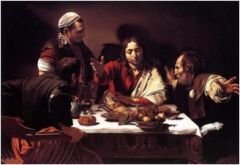
|
Caravaggio (Italian):
*[The Supper at Emmaus, 1601]* • The people are very ordinary • The disciples have tattered clothes • Very realistic • Use of light and dark is much more dramatic • View of the Contarelli • Painting location was Chapel, endowed by Matteo (Matthew) Contarelli in rome o Begging of matthews carrier as disciple • Caravaggio worked in rome • Baroque Painting in Italy and Elsewhere |
|

|
The Calling of St. Matthew (Contarelli Chapel, Rome), 1599-1600 (19.1-2)
• caravaggio • Used actual window as the lighting for painting • Lifesize figures • Light illuminates St. Matthew • Matthew hand is on the money baroque |
|
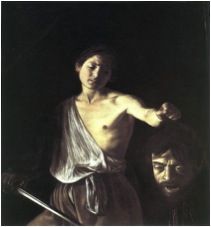
|
*[David with the Head of Goliath, ca. 1609]*
• Late Caravaggio • Head is right at the edge • Dark • His later work there is very little color • Grim and violent • Head of goliath looks almost still alive • Head of goliath is caravaggio’s self-portrait • Sword is right between his own legs • Claimed that Caravaggio was bi |
|
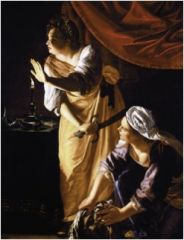
|
Artemisia Gentileschi (Italian): Judith and Her Maidservant with the Head of Holofernes, ca. 1625 (19.5)
• Influenced by carravaggio • Some thought it was nasty and too dark • Female equivalent to david and goliath • Very realistic • Neutral background shallow space • Included source of light in painting • Looks as if they heard a sound not in the bible • Gentileschi’s first name is the name of a women and she was a women • She was one of the important woman artists • Art may show her feeling of women and men seeing she was raped multiple times |
|
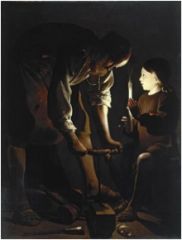
|
Georges de La Tour (French): Joseph the Carpenter, ca. 1642 (21.2)
• Similar idea and light and dark • Nocturnal lighting • Christ holding candle • Light=God baroque italy |
|
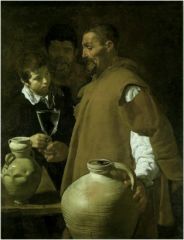
|
Diego Velázquez (Spanish): The Water Carrier of Seville, ca. 1619 (19.35)
• The Caravaggesque style arrives in Spain • Slice of life • Dark neutral background • Fantastic texture • Ordinary man |
|
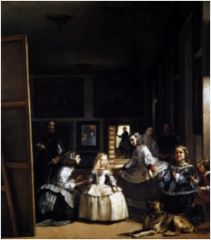
|
Diego Velázquez (Spanish) The Maids of Honor (Las Meninas), 1656 (19.38)
• The “Infanta” (Princess) Margarita • Self-portrait as a painter but you don’t see what hes painting • Reflection in the mirror of king and queen • They are looking at the king and queen |
|
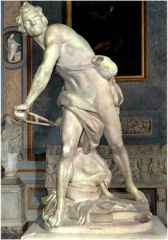
|
Gianlorenzo Bernini: David, 1623 (19.29)
italian Baroque life-size rome energy |
|

|
Gianlorenzo Bernini *[Apollo and Daphne, 1622-24]*
Detail: leaves sprouting from Daphne’s fingers and hair italian baroque sculpture silent scream |
|
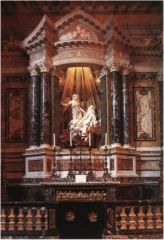
|
The Cornaro Chapel, featuring The Ecstasy of St. Theresa, 1645-52 Gianlorenzo Bernini:
Italain baroque cornaro Chapel Left and right walls of Cornaro Chapel, showing members of the Cornaro family witnessing St. Theresa’s ecstasy rome concealed light above life-size |
|

|
Giovanni Battista Gaulli: Triumph of the Name of Jesus (ceiling of Il Gesù, Rome), 1672-79
Note: Il Gesù is the mother church of the Stucco angels with inscription from St. Paul’s Epistle to the Philippians: “At the name of Jesus every knee should bow” Jesuit Order, founded by Ignatius Loyola in 1540. Detail showing clouds apparently casting shadows on the ceiling Note also stucco sculpture around windows Flanking the windows on both sides of the ceiling are 16 over-life-sized statues in stucco by a follower of Bernini (though Gaulli is said to have designed them), representing diverse lands proselytized by the Jesuits— China, Ethiopia, Mexico, Brazil, etc.—gazing upward in awe. Italian Baroque Sculpture |
|

|
Francesco Borromini: Church of San Carlo alle Quattro Fontane (Rome), 1630s-
Borromini, Church of San Carlo alle Quattro Fontane (St. Charles at the Four Fountains) (Note the undulating façade with a series of concave and convex curves) Angels appearing to support an oval medallion Italian Baroque Sculpture |
|

|
Guarino Guarini: Palazzo Carignano (Turin), begun 1679 (19.24-19.25)
Note “Borrominesque” features: undulating façade (with concave and convex curves) and elliptical courtyard Columns of the vestibule Italian Baroque Sculpture |
|
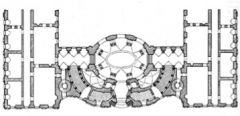
|
Groundplan of Palazzo CarignanoItalian Baroque Sculpture
|
|
|
Dutch (Northern Netherlandish) Baroque Painting
|
The Netherlands Belgium
Holland Flanders Dutch Flemish Independent republic Ruled by Kingdom of Spain Protestant (Calvinist) Catholic Society dominated by Society dominated by middle class: upper class (aristocracy): shapes show society structure as far as the majority of people |
|

|
Rembrandt van Rijn: The Blinding of Samson, 1636 (20.22)
• Large painting • Most dutch paintings were small • Protestant • Old testament • Strong man Samson was fooled by a woman • Samson Blinded very gory • Some Italian influence • Delilah in the back fleeing • Commonly viewed as stable because there are horizontals and verticals • Detail of Delilah fleeing conflicting feelings similar to Detail of Bernini’s Apollo and Daphne Dutch (Northern Netherlandish) Baroque Painting |
|
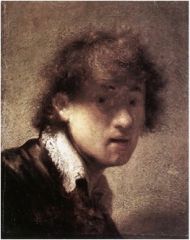
|
*[Self-Portrait (at age 23), 1629]*
Rembrandt • One of 50 self portraits • Apart of study • Wanted to show personality • Young wild and willy • Very small The baroque period concentrates on the flux of the painting |
|
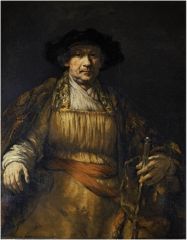
|
Self-Portrait (at age 52), 1658 (20.25)
Rembrandt • Stlye changes as he ages • Depicts himself differently dignified somber stable • Large life size • Frontal figure no movement • Look in face is a lot more obscure • Detail: impasto technique—the thick application of pigment to canvas (result of later work) • A lot more interesting in a way Dutch (Northern Netherlandish) Baroque Painting |
|

|
The Return of the Prodigal Son, ca. 1669 (20.26)
Rembrandt • Story from bible • Large • New testament • Rembrant died this year • High diff between early and old work of Rembrandt • Softer more balance • Shows impasto • Prodigal=wasteful • Boy inherits money spends it all wasteful and comes back during famine • Could be representative of his own life The Return of the Prodigal Son, ca. 1669 (20.26) Dutch (Northern Netherlandish) Baroque Painting |
|
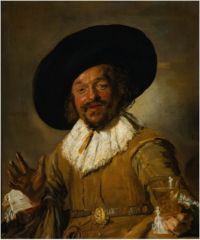
|
Frans Hals: The Jolly Toper (or Merry Drinker), ca. 1628-30 (20.18)
• Seems to be real character • Toper=drinker • Small scale • Slice of everyday life • Expresses emotion and feeling • Impasto • Person reacting Dutch (Northern Netherlandish) Baroque Painting |
|
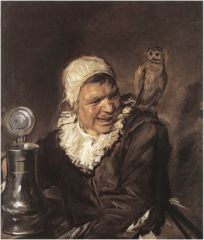
|
Frans Hals: *[Malle Babbe, ca. 1650]* kinda old crone
• Looking to the side • Owl on here shoulder very odd must mean something don’t know what • Not very real • Details another self-portrait • Rapid pace gives it a different feeling Dutch (Northern Netherlandish) Baroque Painting |
|
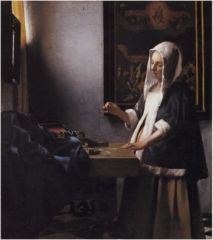
|
Dutch (Northern Netherlandish) Baroque Painting
Jan Vermeer: Woman Holding a Balance, ca. 1664 (20.34) • Vermeer, Woman Holding a Balance—an example of “genre” painting • More typical paintings • Middle class home • No impasto surface smooth • Upper class woman are idle • Vermeer seems to very respectful or women |
|
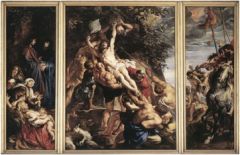
|
Peter Paul Rubens: The Raising of the Cross, 1610-11 (20.1)
• Note: The elevation and display of of Christ’s body relates to the contro- versial doctrines of “real presence” and “transubstantiation.” • about 15 feet high • Highly regarded for 17 century • Came from upper class family • Persuasive • Helped create barouque style • Unstable • New to see the raising of the cross instead of the decending of the cross • Reflects high rennaisaince • Warefare between protestants and catholics Flemish (Southern Netherlandish) Baroque Painting; French Baroque Painting and Architecture |
|
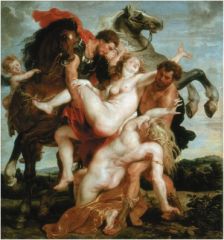
|
(Flemish) *[The Abduction of the Daughters of Leucippus, ca. 1620]*
• Also done by ruben • Shows women from the front and back • Dynamic full women • Sentuality • Mk this is basically classical porn Peter Paul Rubens Flemish (Southern Netherlandish) Baroque Painting; French Baroque Painting and Architecture |
|

|
Nicolas Poussin: The Abduction of the Sabine Women, ca. 1633-34 (21.5)
• Poussin often borrowed figures from well-known classical statues, as seen here gaul killing wife • Violation of women • Baroque artist • Emotions • Shows stages of life Flemish (Southern Netherlandish) Baroque Painting; French Baroque Painting and Architecture |
|
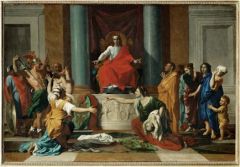
|
(French) *[The Judgment of Solomon, 1649]*
• Poussin • Two women who give birth to children one is dead mother of dead child steals live child and claims it • Evil woman (persecute) • Real mother in surrender (right hand) • Not for sentuality baroque |
|

|
Claude Perrault (and others) (French): East Front of the Louvre (Paris), 1667-70 (21.12)
• Used to be royal palace French Baroque architecture is less extravagant than Italian Baroque, but more classical. • Elements of the Louvre are adapted from architectural monuments of classical antiquity, as suggested by this comparison. |
|
|
contrast between baroque and rococo
|
BAROQUE ROCOCO
Salon de la Guerre Salon de la Princesse (Versailles) (Hôtel de Soubise) Gaulli (Il Gesù) Tiepolo (Kaisersaal) Rubens Watteau and Boucher Bernini Clodion |
|
|
enlightenment
|
Age of Reason, of rational thought and questioning of old beliefs
|
|
|
18th century
|
The “Enlightenment” or Age of Reason, of rational thought and questioning of old beliefs
• The Industrial Revolution • Political Revolutions: American Revolution, 1776 French Revolution, 1789 |
|
|
rococo
|
The word Rococo probably derives from the
French word rocaille (pronounced “ro-kye”), a type of ornament employing rock, pebbles, and shells in garden decoration. • It was a “made-up” word, invented toward the end of the 18th century. Meant to sound rather silly, it was originally used as an insulting term for the art of the ancien régime—the recently overthrown French monarchy. |
|

|
[Germain Boffrand (French): The Salon de la Princesse in the Hôtel de Soubise
• Note the unification of painting, sculpture, and architecture; the play of curves and counter-curves; the plaster Cupids; and the paintings dealing with love, a typical Rococo theme. • Rococo subject matter is frequently erotic. (The word “erotic” derives from Eros, the Greek equivalent of Cupid; it means“pertaining to sexual love.”) • the subject matter is less of religion and more of “love” especially of upper class and erotic • lots of cupids • (Paris), 1732] |
|

|
Giovanni Battista Tiepolo: Ceiling fresco: Kaisersaal (“Imperial Hall”) of the Residenz
(Italian) (Prince-Bishop’s “Residence”) (Würzburg, Germany), • 1751 (22.25) • with frescoes by Tiepolo |
|
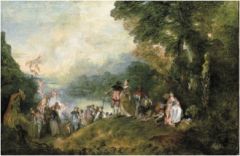
|
Jean-Antoine Watteau (French): A Pilgrimage to Cythera, 1717 (22.1)
• Note—The first fête galante (“gallant festivity” or scene of gallantry): a charac- teristic type of Rococo painting in which small-scale figures of aristocratic ladies and gentlemen are shown amusing themselves in a garden or parkland setting. • Art for the purpose of delight not intellect • No straight lines • Island of love and enchantment • Groups of upper class man have made a pilgramage • Cupids • Sweet sadness |
|
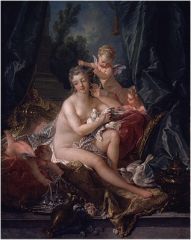
|
François Boucher (French): The Toilet of Venus, 1751 (22.5)
• Another Rococo painting with erotic content • Painted for Madame de Pompadour, mistress of King Louis XV o She was influential • Probably an illusion to a play preformed o She stared in the play • Subtle difference between rococo and Baroque • Mirror of their dreams |
|

|
Jean-Honoré Fragonard (French): The Swing, 1767 (22.6)
• Another fête galante with erotic content • Small dainty painting • Aristocratic • Fragonard was a pupil of Boucher • Man in left corner is patron looking at stockings of mistress • Empty headed china doll • Slipper falls off • Cupid- |
|

|
Clodion (Claude Michel, French): Nymph and Satyr Carousing (terra cotta), ca. 1780 (22.13)
• Arousing • Beast within us |
|

|
Jacques-Louis David (French): The Oath of the Horatii, 1784 (23.29)
• Represents an early phase of Romanticism, usually called Neoclassicism • Jac is associated with the French revolution • Has nothing in common with rococo • Large • Goes back poussin style • Detail: the Horatii (sons of Horatius) • People actually acted this scene out • Wants a very accurate representation of what happened |
|

|
Jacques-Louis David (French): The Death of Marat, 1793 (23.30)
• Political assassination of Marat • Key player in the French revolution • Contracted a disease, baths soothed him • Woman stabs him while he is reading letter • One again attempt to be very accurate • Was almost like a picture in a newspaper • Detail: Charlotte Corday’s letter of introduction • Takin out of real time and real space • Romanticism • Christ-like quality’s were givin to Marat, a kind of secular religion, against the catholic church • Martyr of the revolution |
|
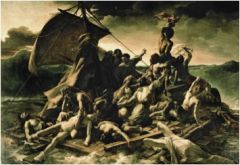
|
Théodore Géricault (French): The Raft of the “Medusa”, 1818-19 (24.20)
• very large • French revolution • Medusa is the name of the boat, boat sinks, 15 people alive, five dead • Sense of accuracy • Black west Africans in the painting |
|
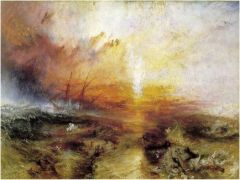
|
Joseph Mallord William Turner (British): The Slave Ship, 1840 (24.9)
• Slavers Throwing Overboard the Dead and the Dying: Typhoon Coming On (actual original title) • Represents contemporary event • Based on a poem of a slave ship caught in a storm • Also based on actual account • Big scandal, disease broke out in slave quarters, so threw all sick overboard so that the could be reimbursed • This style is new romantacism period |
|
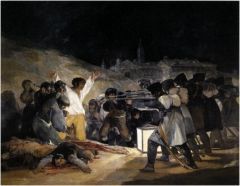
|
Francisco Goya (Spanish): The Third of May 1808, 1814 (24.3)
• After french rev, anarchy starts, conquers the kingdom of spain • May 3 Spain’s independence day • Politics and art |
|
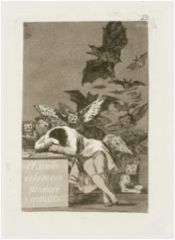
|
Francisco Goya (Spanish): The Sleep of Reason Produces Monsters, 1799 (24.1)
|
|

|
Francisco Goya (Spanish): Untitled (Saturn Devouring One of His Children), ca. 1819-23 (24.4
• Goya, Untitled (Saturn Devouring One of His Children): a late work by the artist—one of the so-called black paintings” (pinturas negras) |
|
|
realism
|
mportance of painting only what is seen and accepted as real
• Courbet: “Show me an angel, and I’ll paint one.” • Courbet: “Everything that does not appear on the retina lies outside the domain of painting.” • Baudelaire: “One must be of one’s time.” (“Il faut être de son temps.”) (Note Courbet’s use of the term “Realism” in his 1855 exhibition On Realism (Du Réalisme) and in his pamphlet entitled Manifesto of Realism.) |
|
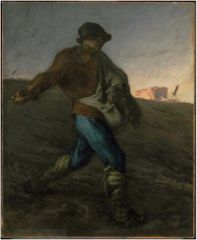
|
Jean-François Millet: The Sower, ca. 1850 (25.3)
• Realism often depicted famer-esque people • May possibly have been influenced my micheal angelo • Hero-like quality, dignity of toil • Could this be an illustration of the biblical passage (from Ecclesiastes 11: 6), “In the morning sow thy seed, and in the evening withhold not thine hand . . .”? |
|

|
Gustave Courbet: The Stone Breakers, 1849 (25.2)
• Refered to himself as the most arrogant man in frace • Liked to be shocking and offensive • Courbet: “I am fifty years old, and I have always lived in freedom. Let me end my life free. When I am dead, let this be said of me: He belonged to no school, to no church, to no institution, to no academy, least of all to any régime except the régime of liberty. ” • Lower class people • Neutral, documentary • Real, but cant see their face • Man too old, boy too young • Born poor die poor • Large painting • realism |
|

|
Gustave Courbet: Burial at Ornans, 1849-50 (25.1)
• Courbet: “The Burial at Ornans was in reality the burial of Romanticism.” • No one know whose burial it is • Humongous, somewhat vulgar • Political illusion with the cross • Drab and dull, part of realism |
|
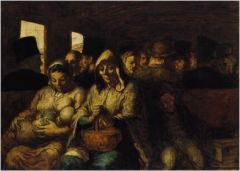
|
Honoré Daumier: The Third-Class Carriage, ca. 1863-65 (25.5)
• Known as a satirist • Cartoonist • Showing the lowest class of people • View as if you were also in the the same area sitting down • Different stages to life, biblical? Virgin marry Christ-child and cousin? • realism |
|

|
Édouard Manet: The Luncheon on the Grass (Le Déjeuner sur l’Herbe), 1863
(25.10) • as a flâneur—a sort of “man about town” (1867) • wealthy man, which is why is was rather radical in his work • Exhibited in the Salon des refusés (Salon of the Refused) • Large, life size • Real but unrealistic • The women is naked but not “nude” • Male fantasy? But women is looking out at viewer, prostitute? • The painting was submitted and refused, but what he was doing only what has been done before • Women is very flat |
|
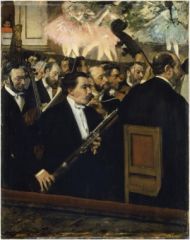
|
Edgar Degas: The Orchestra of the Paris Opera, 1868-69 (25.12)
• Illusive artist • Inspired by manet • The viewer is up close in the pit • Makes you want to know what they are looking at, something is going on • Snapshot like quality • Different technique used a lot free-er • From lower-class, rural labor to middle-class, urban entertainment: a prelude to Impressionism |
|
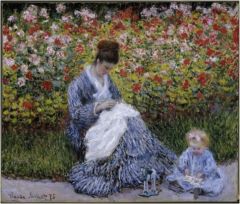
|
Claude Monet: *[Madame Monet and Child, 1875]*
Note: plein air (“open air”) painting, referring to paintings done out of doors—en plein air—on the spot Detail showing “broken color”: colors applied in spots or patches rather than the traditional method of smoothly blending them maddona and child |
|
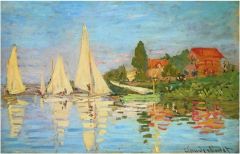
|
*[Sailboats at Argenteuil, 1874]* Monet
impressionism broken color again |
|

|
Auguste Renoir: The Luncheon of the Boating Party, 1881 (25.16)
impressionism in the Phillips Collection, Washington Renoir’s broken colors are less “broken” than Monet’s! |
|

|
Berthe Morisot: Summer’s Day (The Lake in the Bois de Boulogne), ca. 1879
impressionism plein air |
|
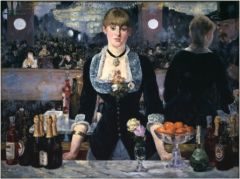
|
É douard Manet: A Bar at the Folies-Bergère, 1881-82 (25.18)
impressionism |
|
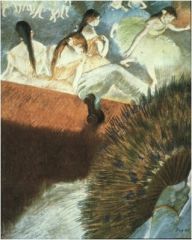
|
Edgar Degas: *[At the Theater (pastel), 1881]*
|
|
|
timeline
|
Baroque-1600
Rococo-1700 Romanticism/realism-1800 Impressionism-1875 |

